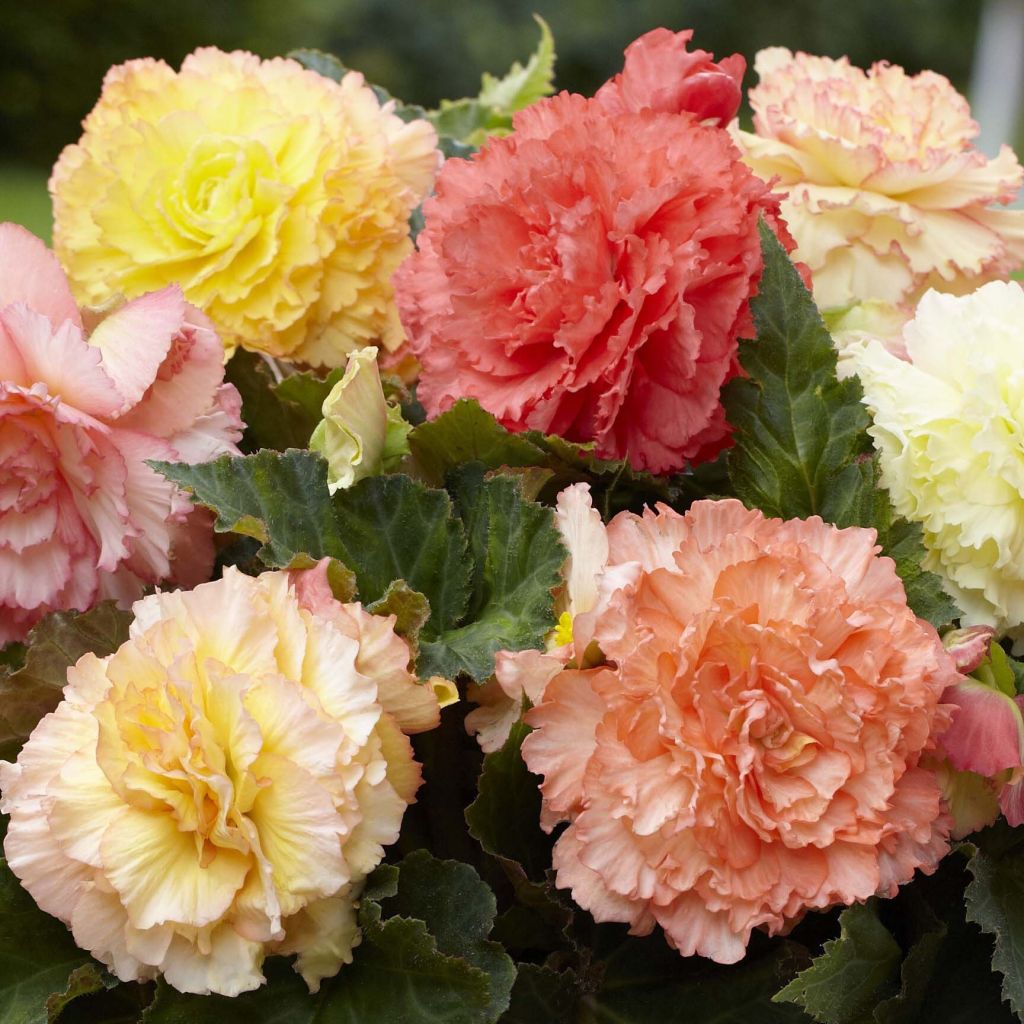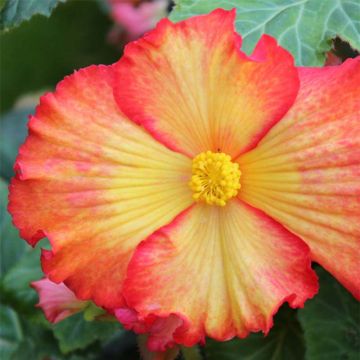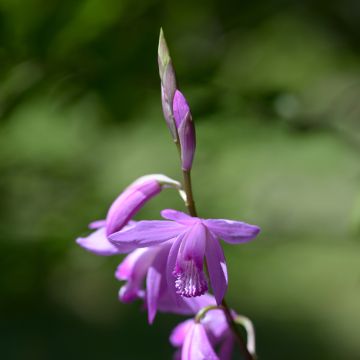

Begonia multiflora pastel Mix


Begonia multiflora pastel Mix
Begonia multiflora pastel Mix
Begonia multiflora pastel Mix
Begonia
This item cannot be shipped to the selected country
Delivery charge from €5.90
More information
Schedule delivery date,
and select date in basket
This plant carries a 6 months recovery warranty
More information
We guarantee the quality of our plants for a full growing cycle, and will replace at our expense any plant that fails to recover under normal climatic and planting conditions.
From €5.90 for pickup delivery and €6.90 for home delivery
Express home delivery from €8.90.
Does this plant fit my garden?
Set up your Plantfit profile →
Description
The Pastel Begonia Mix brings together different varieties of charming begonias with large double flowers resembling roses, displaying various tender pastel colours. Depending on the plants, they can be white, pale yellow, salmon, soft coral pink, or even apricot. These particularly floriferous begonias bloom continuously from early summer until the first frost. They have a compact habit that looks wonderful at the front of flower beds. They are also perfect in pots for decorating terraces and balconies. They are irreplaceable for brightening up slightly shaded areas.
The genus Begonia belongs to the begonia family. Mostly originating from intertropical rainforests, these plants have either a fleshy underground stem, a rhizome, or a tuber. The Pastel Begonia is a tuberous variety belonging to the multiflora category, which is characterized by smaller but abundantly present flowers throughout the summer, from June until the end of October. It has an upright habit and reaches an average height of 35cm (14in) and a slightly smaller width. The foliage is deciduous, dark green in colour, with more or less veining and marbling. The asymmetrical leaf blades are characteristic of the genus and contribute to the exotic charm of begonias. The plant is herbaceous, and the tissues are filled with water, making them succulent stems. The flowers are fully double, turbinate, 6cm (2in) wide, and come in various colours, depending on the plants. This begonia goes into dormancy in autumn, its growth resumes in spring when temperatures rise and daylight duration increases. The tuber, resembling a flattened potato, remains dry and cool during winter.
The Multiflora Begonia adapts to shade, provided it receives a few hours of sunlight per day. It prefers light soils rich in organic matter that do not retain moisture. Begonias are frost-sensitive plants and cannot tolerate negative temperatures. For this reason, they are often cultivated in pots or containers that can easily be moved to cold greenhouses or verandas at the first frost. If planted in the ground, the tubers should be stored away at the end of flowering and kept sheltered until the following spring. Abundantly planted in flower beds in our cities, compact begonias with a non-trailing habit make excellent bedding plants. They are also very easy to grow in pots, suitable for all gardeners, even beginners. For example, you can combine them with ground ivy, forget-me-nots, or lobelias.
Report an error about the product description
Begonia multiflora pastel Mix in pictures




Plant habit
Flowering
Foliage
Botanical data
Begonia
multiflora
pastel Mix
Begoniaceae
Begonia
Cultivar or hybrid
Other Begonias
Planting and care
Plant your pastel begonias in a mix in a shady or slightly sunny location, in light and moist soil rich in humus. Begonias are sensitive to heavy soils, so lighten it if necessary with some sand. Plant after the last frost, one per pot about twenty cm apart, or spaced 25cm (10in) apart in open ground. Position the tuber with the concave (hollow) part facing upwards and cover with 5cm (2in) of soil. Like Dahlias, you can speed up their growth cycle by planting them as early as February, in pots, kept sheltered, and then taking them out in May. Water regularly. Apply begonia fertilizer at planting, and then twice a month during the season. Remove faded flowers. Dig up the bulbs before the first frost, and store them in a bit of turf, in a dry and cool place, during the winter.
Planting period
Intended location
Care
This item has not been reviewed yet - be the first to leave a review about it.
Bulbs to grow in pots
Haven't found what you were looking for?
Hardiness is the lowest winter temperature a plant can endure without suffering serious damage or even dying. However, hardiness is affected by location (a sheltered area, such as a patio), protection (winter cover) and soil type (hardiness is improved by well-drained soil).

Photo Sharing Terms & Conditions
In order to encourage gardeners to interact and share their experiences, Promesse de fleurs offers various media enabling content to be uploaded onto its Site - in particular via the ‘Photo sharing’ module.
The User agrees to refrain from:
- Posting any content that is illegal, prejudicial, insulting, racist, inciteful to hatred, revisionist, contrary to public decency, that infringes on privacy or on the privacy rights of third parties, in particular the publicity rights of persons and goods, intellectual property rights, or the right to privacy.
- Submitting content on behalf of a third party;
- Impersonate the identity of a third party and/or publish any personal information about a third party;
In general, the User undertakes to refrain from any unethical behaviour.
All Content (in particular text, comments, files, images, photos, videos, creative works, etc.), which may be subject to property or intellectual property rights, image or other private rights, shall remain the property of the User, subject to the limited rights granted by the terms of the licence granted by Promesse de fleurs as stated below. Users are at liberty to publish or not to publish such Content on the Site, notably via the ‘Photo Sharing’ facility, and accept that this Content shall be made public and freely accessible, notably on the Internet.
Users further acknowledge, undertake to have ,and guarantee that they hold all necessary rights and permissions to publish such material on the Site, in particular with regard to the legislation in force pertaining to any privacy, property, intellectual property, image, or contractual rights, or rights of any other nature. By publishing such Content on the Site, Users acknowledge accepting full liability as publishers of the Content within the meaning of the law, and grant Promesse de fleurs, free of charge, an inclusive, worldwide licence for the said Content for the entire duration of its publication, including all reproduction, representation, up/downloading, displaying, performing, transmission, and storage rights.
Users also grant permission for their name to be linked to the Content and accept that this link may not always be made available.
By engaging in posting material, Users consent to their Content becoming automatically accessible on the Internet, in particular on other sites and/or blogs and/or web pages of the Promesse de fleurs site, including in particular social pages and the Promesse de fleurs catalogue.
Users may secure the removal of entrusted content free of charge by issuing a simple request via our contact form.
The flowering period indicated on our website applies to countries and regions located in USDA zone 8 (France, the United Kingdom, Ireland, the Netherlands, etc.)
It will vary according to where you live:
- In zones 9 to 10 (Italy, Spain, Greece, etc.), flowering will occur about 2 to 4 weeks earlier.
- In zones 6 to 7 (Germany, Poland, Slovenia, and lower mountainous regions), flowering will be delayed by 2 to 3 weeks.
- In zone 5 (Central Europe, Scandinavia), blooming will be delayed by 3 to 5 weeks.
In temperate climates, pruning of spring-flowering shrubs (forsythia, spireas, etc.) should be done just after flowering.
Pruning of summer-flowering shrubs (Indian Lilac, Perovskia, etc.) can be done in winter or spring.
In cold regions as well as with frost-sensitive plants, avoid pruning too early when severe frosts may still occur.
The planting period indicated on our website applies to countries and regions located in USDA zone 8 (France, United Kingdom, Ireland, Netherlands).
It will vary according to where you live:
- In Mediterranean zones (Marseille, Madrid, Milan, etc.), autumn and winter are the best planting periods.
- In continental zones (Strasbourg, Munich, Vienna, etc.), delay planting by 2 to 3 weeks in spring and bring it forward by 2 to 4 weeks in autumn.
- In mountainous regions (the Alps, Pyrenees, Carpathians, etc.), it is best to plant in late spring (May-June) or late summer (August-September).
The harvesting period indicated on our website applies to countries and regions in USDA zone 8 (France, England, Ireland, the Netherlands).
In colder areas (Scandinavia, Poland, Austria...) fruit and vegetable harvests are likely to be delayed by 3-4 weeks.
In warmer areas (Italy, Spain, Greece, etc.), harvesting will probably take place earlier, depending on weather conditions.
The sowing periods indicated on our website apply to countries and regions within USDA Zone 8 (France, UK, Ireland, Netherlands).
In colder areas (Scandinavia, Poland, Austria...), delay any outdoor sowing by 3-4 weeks, or sow under glass.
In warmer climes (Italy, Spain, Greece, etc.), bring outdoor sowing forward by a few weeks.























































